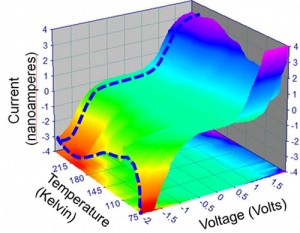
Inserting helium atoms (visualized as a red balloon) into a crystalline film (gold) allowed Oak Ridge National Laboratory researchers to control the material’s elongation in a single direction. (Submitted image)
Researchers at Oak Ridge National Laboratory have developed a new method to manipulate a wide range of materials and their behavior using only a handful of helium ions.
The team’s technique, published in Physical Review Letters, advances the understanding and use of complex oxide materials that boast unusual properties such as superconductivity and colossal magnetoresistance but are notoriously difficult to control.
For the first time, ORNL researchers have discovered a simple way to control the elongation of a crystalline material along a single direction without changing the length along the other directions or damaging the crystalline structure. This is accomplished by adding a few helium ions into a complex oxide material and provides a never before possible level of control over magnetic and electronic properties.
“By putting a little helium into the material, we’re able to control strain along a single axis,†said ORNL’s Zac Ward, who led the team’s study. “This type of control wasn’t possible before, and it allows you to tune material properties with a finesse that we haven’t previously had access to.†[Read more…]
